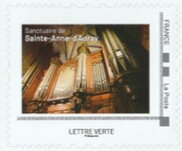Stamp: Organ Saint-Anne-d'Auray (France 2025)
Organ Saint-Anne-d'Auray (France 2025)
16 June (France ) within release Collector : Architectural Heritage of Saint-Anne-d'Auray goes into circulation Stamp Organ Saint-Anne-d'Auray face value Lettre No Face Value
| Stamp Organ Saint-Anne-d'Auray in catalogues | |
|---|---|
| Colnect codes: | Col: FR-COL 2025-24/8 |
Stamp is square format.
Also in the issue Collector : Architectural Heritage of Saint-Anne-d'Auray:
- Stamp - Academy of Sacred Music and Art Saint-Anne-d'Auray face value Lettre;
- Souvenir Sheet - Architectural Heritage of Saint-Anne-d'Auray face value 8*Lettre;
- Stamp - Basilica Saint-Anne-d'Auray face value Lettre;
- Stamp - Fountain Saint-Anne-d'Auray face value Lettre;
- Stamp - Memorial Saint-Anne-d'Auray face value Lettre;
- Stamp - Model of 'La Sainte Anne' Saint-Anne-d'Auray face value Lettre;
- Stamp - Organ Saint-Anne-d'Auray face value Lettre;
- Stamp - Saint-Anne-d'Auray Cloister face value Lettre;
- Stamp - Saint-Anne-d'Auray Scala Sancta / Holy Ladder face value Lettre;
Stamp Organ Saint-Anne-d'Auray it reflects the thematic directions:
A church building, often simply called a church, is a building used for Christian religious activities, particularly worship services. The term in its architectural sense is most often used by Christians to refer to their religious buildings, but it is sometimes used (by analogy) for buildings of other religions. In traditional Christian architecture, the church is often arranged in the shape of a Christian cross. When viewed from plan view the longest part of a cross is represented by the aisle and the junction of the cross is located at the altar area. Towers or domes are often added with the intention of directing the eye of the viewer towards the heavens and inspiring church visitors. Modern church buildings have a variety of architectural styles and layouts; many buildings that were designed for other purposes have now been converted for church use; and, similarly, many original church buildings have been put to other uses. The earliest identified Christian church was a house church founded between 233 and 256. During the 11th through 14th centuries, a wave of building of cathedrals and smaller parish churches occurred across Western Europe. A cathedral is a church, usually Roman Catholic, Anglican, Oriental Orthodox or Eastern Orthodox, housing the seat of a bishop.
A musical instrument is a device created or adapted to make musical sounds. In principle, any object that produces sound can be considered a musical instrument—it is through purpose that the object becomes a musical instrument. A person who plays a musical instrument is known as an instrumentalist. The history of musical instruments dates to the beginnings of human culture. Early musical instruments may have been used for rituals, such as a horn to signal success on the hunt, or a drum in a religious ceremony. Cultures eventually developed composition and performance of melodies for entertainment. Musical instruments evolved in step with changing applications and technologies.

